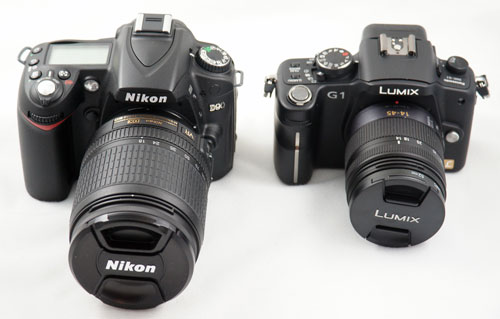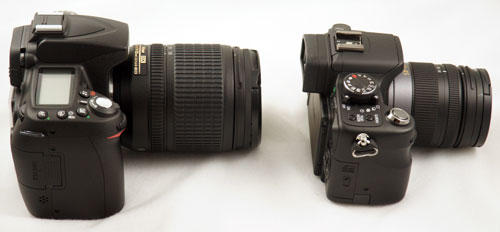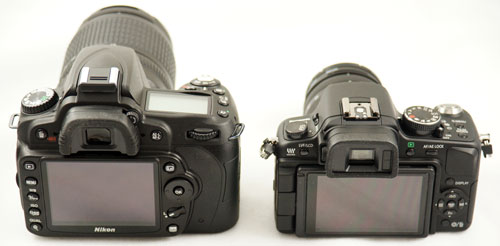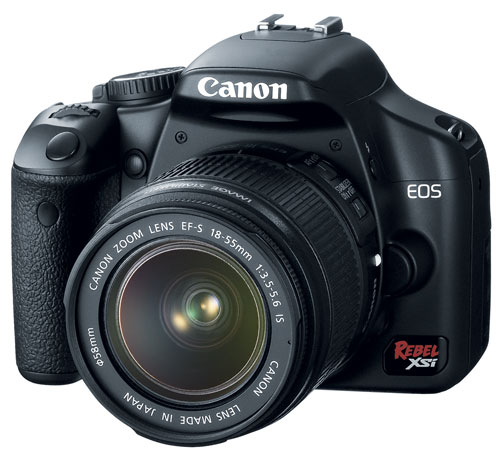Digital Cameras for the Holidays
by Wesley Fink on November 27, 2008 12:00 AM EST- Posted in
- Digital Camera
Entry Interchangeable Lens
Why should you spend more money for a DSLR than a point-and-shoot camera, when resolutions appear similar and the point-and-shoots offer the same features? It's all about the sensor and flexibility. The senor is an analogue device that converts light to a digital signal, so the larger the light gathering points (pixels) the more the ability to gather light and distinguish fine detail. The DSLR sensor is at least ten times larger than the typical P&S, so it can gather more light and resolve finer variations in that light. This means the image quality will be better with a DSLR and the sensor is capable of providing good images over a much wider range of light conditions than a P&S.
This category also features interchangeable lenses so you can choose to mount a wide variety of lenses designed for certain purposes - fast speed for low light, fast telephotos for sports, long telephotos for bird-watching, super wide-angle for sweeping landscapes, etc. The category name had to be changed this year to make way for a brand new category of digital camera. The Panasonic G1 is the first, but likely just the beginning, of the interchangeable lens digital camera without a mirror-box. That means it is not an SLR, but it does compete in the DSLR market space.

A Panasonic G1 recently landed in the lab, and we are mightily impressed. The descriptions of this little mirrorless interchangeable lens digital camera intrigued us, as they did everyone, but in the flesh the G1 is even more revolutionary and impressive.



You can see how small the G1 really is side-by-side with the new Nikon D90. There is the potential for micro 4/3 to go even smaller. The tiny 14-45mm zoom (28-90mm equivalent) really sets the size standard around which the 4/3 system will be built. What the pictures can't show is that while the G1 is small it does not feel cheap or too tiny in the hands. Ergonomics are very good, and the rubberized covering of the body will be loved by most and hated by a few.
The 23-point contrast detect AF is remarkably fast, so you can forget about Live View AF as a limitation - because it is fast on the G1, as fast as an optical DSLR with good phase-detect focusing. The view on the flexible 3" tilt-and-swivel LCD is very bright and clear, and as big as it gets in this class. The detail, with a 420,000 pixel screen, is better than anything else in its category.
The viewfinder is also electronic, but it's not like any of the limited EVF finders we have seen in the past. In most situations you have to remind yourself that this is an EVF, since the view is bigger and brighter than the normal DSLR with a pentamirror. It only gives itself away in very low light where the EVF becomes gritty and tears, but otherwise it is not a handicap at all.
There's lots of good news with the G1, but there is also the price. After using a G1, I understand the pricing at $795 - because it can easily compete in the prosumer class and $795 is a bargain in that space. However, that is not where the G1 will compete. It will be trying to grab market share from entry DSLRs where a $500 price is more appropriate. Fortunately, we already see dealers on eBay selling the G1 kit for $649 to $695. Special promotions like Microsoft Live Search cashback can reduce the price another 25%, getting the eBay final cost down to around $500, where the G1 is an incredible value.
The G1 by itself is good enough to compete in the prosumer market, and that says a lot. However, the micro 4/3 lens system is not here yet. Until there are more choices in micro 4/3 lenses and more 4/3 lenses that work completely on micro 4/3, the system can only be viewed as entry. The potential is certainly there, and as it is the G1 is an easy choice as an entry camera recommendation. You will see more about the G1 in an upcoming review.

In looking at a traditional DSLR in the entry class, the first consideration has to be value. As you saw in Sony A200: Entry DSLR Roundup, the Sony A200 stands out as a great value in a crowded field. The A200 inherits the sensor and electronics refinements of the A350/A300/A700 in a package that updates the A100, a camera originally designed to sell for twice the price of the $499 A200.
The 10.2MP A200 has faster AF than the A100, a larger 2.7" LCD, faster image processing, and more robust adjustment ranges. It also shares an optional battery grip with the A300/A350, correcting an omission on the A100. Neither the Nikon D60 or Olympus E420/E520 offer a battery grip option. The in-body image stabilization, is even more effective on the A200 and it works with any lens you can mount on the camera.
The Sony A200K, which includes the 18-70mm lens, is widely available for $499 or less. However, the 2-lens A200W is the real bargain right now with Sony instant rebates. You can get the two-lens kit, with the addition of the 75-300mm zoom, for around $549 at Amazon and other large etailers. The second lens normally adds $200 to the kit price.

You can never go wrong buying Canon or Nikon as your first serious camera, and it turns out the Canon XSi remains one of the best buys in the Canon line. The XSi price has dropped quite a bit since it was introduced and you can now find this superb 12.2MP camera for $650 or less with the Cannon 18-55mm IS (Image Stabilized) lens. Canon IS is in the lenses and not in the camera body, so you will need to buy IS lenses for that feature.

If every penny counts, as it does for many in these economic times, the 10MP Canon XS provides most of the XSi features in a cheaper package. The XS with the 18-55mm IS lens is selling for around $499, which is the same price as the Sony A200.
Both the XSi and XS feature Live View, which lets the user use the LCD to compose and focus pictures. This is a feature that is missing on the Sony A200. However, Live View focusing is very slow on most of today's DSLR cameras, with the exception of the Sony A300/A350, which feature Live View on a tilt LCD as their primary shooting mode. If Live View interests you, check out these two Sony models as well. The Panasonic G1 is also a Live View camera, but the fast 23-point Live View AF and flexible, accurate tilt-and swivel 3 inch LCD make it a no-compromise Live View solution.










41 Comments
View All Comments
Flyboy27 - Friday, November 28, 2008 - link
Nikon D40. Seriously why would I need anything with more MP. Talk about fast and easy to use. Size and weight are very reasonable too. I can turn it on and take a picture before your p/s warms up.Flyboy27 - Friday, November 28, 2008 - link
I would like anandtech to have a serious discussion about magapixels. Why do higher megapixels matter? For web? no! The only way MPs matter is if your printing huge and by huge I mean greater than 20x30. How many times do you need prints that big anyways. Anyone that wants ultimate resolution is going to shoot film anyways. Film can be scanned by a professional lab at higher resolution than any DSLR can take. Just because you have a 20MP camera doesn't mean that you can resolve all those pixels anyways. My point? It is dumb to pay more for more megapixels. Any modern digital camera has enough MPs for any amateur and most pros.WTF is pro-sumer? = amateur photo geek with money. I doubt that pro photographers read this site for advice on cameras. They know what they want already.
All this said (if you want an upgrade from the D40) I think the D90 by Nikon would be a great camera if you want to go that route. It is not worth paying more for any other camera.
I bought a DSLR for the ability to learn to use an SLR camera without having to pay for film. I can learn from my mistakes instantly instead of waiting for film to be developed/scanned. If I already knew how to use an SLR and was comfortable I would be shooting 35mm film and getting it scanned at a much higher resolution than any digital camera.
Wesley Fink - Saturday, November 29, 2008 - link
If readers want to look a little deeper at sensor resolution, sensor size, and noise, take a look at our two part series on the Digital Sensor in The Digital Sensor: A Guide to Understanding Digital Cameras at http://www.anandtech.com/digitalcameras/showdoc.as...">http://www.anandtech.com/digitalcameras/showdoc.as... and The Digital Sensor: Part 2 at http://www.anandtech.com/digitalcameras/showdoc.as...">http://www.anandtech.com/digitalcameras/showdoc.as....Flyboy27 - Saturday, November 29, 2008 - link
Thanks Wesley,I wont go into Digital vs. Film. That is something that a person can only decide for himself. I've already gone into my reasons why I shoot digitally. Besides its all about getting great pictures right? It is my belief that you can get great pictures from most of the cameras out there. Some cameras just make it easier to take more great pictures.
Now my beef with resolution. Just as you have to sit close enough to a 1080p TV at a given size to tell the difference between it and a 720p set the same goes with digital photography. You have to ask yourself "What am I doing with these pictures that I'm going to be taking?" Am I going to make wall size prints? probably not. Am I going to make 20x30" prints? Maybe a few. Am I going to make 5x7s or 12x18s. Definitely. Am I going to use these photos on the web? Most Definitely. These are my answers and yours may be different but based on mine all I'll ever need is 6-10 mp. Fantastic, I don't have to pay extra for more mega pixels just because all the marketing says I do. Marketing tries it's hardest to make you go out an buy more than you need because they have to make money in order to make more cameras and stay in business.
I do take issue with Norman Koren's test. In the test he scanned the film with a $700 scanner. Big deal. He just wiped out any advantage that film might have. He's comparing a digital camera with a scanner, not film. Once again I'm not saying film or digital are better than one another. Pros use both.
I will check out Clark looks interesting and very technical.
I do love anandtech. Quality articles, objective testing. I've recently stopped reading another site due to the slow decline in the quality of their articles/publishing philosophy. Anandtech is now my main source for news and advice on computer hardware. Plus you actually respond intelligently to commentators and most of the commentators comment intelligently as well. Thanks guys.
Wesley Fink - Saturday, November 29, 2008 - link
Can you please provide the source for your information that film has higher resolution than any digital sensor? There are many experts who disagree with you.Norman Koren, the author of Imatest, which is a well-respected Resolution Test Suite, found the resolution of the top films to be equivalent to an 8.3 megapixel full-frame DSLR sensor at http://www.normankoren.com/Tutorials/MTF7.html">http://www.normankoren.com/Tutorials/MTF7.html. Clark at
http://www.clarkvision.com/imagedetail/film.vs.dig...">http://www.clarkvision.com/imagedetail/film.vs.dig... found that Fuji Velvia 100 and 50 were equivalent to a 10 megapixel sensor for intensity detail, and perhaps a 16 megapixel sensor for color detail. All other films he tested, including slide films, were lower in resolution. You can find charts for a wide variety of films at that link.
Clark's final conclusion was 10 to 16 megapixels were the equivalent range of the various film types. Since his work was mostly APS-C sensors it is not really at odds with Koran's tests.
Every other researcher who has tested has generally found 12 to 14 megapixels the equivalent of 35mm film. The larger resolution sensors do show any faults of your lenses and they require the very best glass to resolve those high resolutions.
We did discuss the relevance of megapixels in the article in the discussion of P&S cameras. Our recommendation was that cameras with these tiny sensors - 1/10 to 1/20 the size of an APS-C sensor - have reached the best balance of resolution and noise at around 7 to 9 megapixels. Anything more than this is a waste with these tiny sensors TODAY, but that could change with new sensor technology.
However, in the APS-C sensor the resolution trade-off probably is somewhere around 20 to 25 megapixels with current technology and somewhere around 40 to 50 megapixels in full-frame. Since the sensor is an Analog device that gathers light and converts it to digital info the physical size of the pixel is the most important specification for judging ISO range and noise.
Prosumer is a designation used by almost every camera review site. It is the same as Advanced Amateur. It basically means a class of cameras geared to the hobbyist or advanced amateur that is also used by some Pros. The lines have become particularly blurred as sealing has improved in this class and technical advances have accelerated in digital imaging.
computerfarmer - Friday, November 28, 2008 - link
Nikon D40 is a good camera with 6mp. Then there is the Nikon D40x with 10mp. Both have 23.7 x 15.6 mm CCD sensors. The D40x has ISO 100 and the D40 does not, it starts at ISO 200. The D60 has very little on the D40x and in some cases the D40x is better.You are correct in the fact the D40 will do the job and very well at that.
Nehemoth - Friday, November 28, 2008 - link
I would like to get one new camera bellow the 200US mark, but I don't like the cannon design and I would like that only use 2 AA batteries (so some fujifilm are out), also I like the aesthetics of those old cameras, like DSLR design.Any recomendation?.
computerfarmer - Friday, November 28, 2008 - link
The FujiFilm FinePix S700 has the DSLR look and is selling for 179CDN. It uses 4 AA batteries and has a 10x zoom. you can read user comments herehttp://www.dpreview.com/reviews/read_opinions.asp?...">http://www.dpreview.com/reviews/read_opinions.asp?...
Good luck
Nehemoth - Friday, November 28, 2008 - link
That's what I said before, I don't want fujitsu cause use 4 batteries, I would like of just 2 batteries.ubiloo - Friday, November 28, 2008 - link
I've been shooting since more than 20 years, I've used a lot of cameras from Canon, Nikon and Pentax.Even though the Pentax lacks a full-frame camera (shame! shame!), I'm deeply convinced of the fact that some current models really are among the best for the price. Why is Pentax so often absent from parades?
In particular, I think that the K200D is terrifying for its street price (I don't know about the K-m); I've now been using it for some time and it's a real solid camera with good, sometimes very good, picture quality. I bought it for at least €100 than any comparable camera. This particular model also deletes one of the drawbacks of previous models: with its kit lens, the auto-focus speed is really convincing, try to believe!
As for lenses, both Sigma and Tamron are available, so whenever Pentax is weak, they deliver...